
No matter a student's major, minor, or field of interest, Notre Dame's undergraduate-centered educational model allows students to find research opportunities in many departments, centers, and institutes across campus.
Our key research areas lead our efforts while the Flatley Center for Undergraduate Scholarly Engagement supports student engagement, from one-on-one advising to securing funding.
Some students work in labs, some partner with professors for special projects, and many Notre Dame undergrads find themselves traveling throughout the United States and even abroad to conduct research over their breaks. Research isn't just accomplished in a lab here.
Meet six students whose research ranges from studying structural design in Germany to solar panels and green design to understanding correlations between mental illness and aggression.
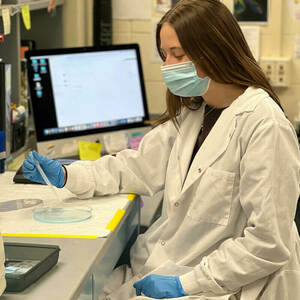
Allison Healy '24
Major: Biological sciences
Minors: Health, Humanities, and Society
What I do:
characterize the gene amt in the context of kidney development. amt encodes an enzyme that is a vital component of the glycine cleavage system. We know that dysfunctional amt leads to a decrease in the efficiency of the glycine cleavage system, and it can cause the rare disease, nonketotic hyperglycinemia (NKH). Symptoms of NKH include seizures, spasticity, developmental delay, and early death. My research mentor, PhD candidate Nicole Weaver, is currently characterizing gldc, another component of the glycine cleavage system that functions to break down glycine into single carbon units. Interestingly, amt and gldc are heavily expressed in the nervous system, but also within the developing kidney. This expression has led to a wide range of questions as to how amt functions in nephrogenesis.
The Wingert Lab focuses on kidney development, regeneration, and aging. Additionally, the lab is involved with stem cell research and rare disease research.
How I got started:
My interest in research began during my second semester of my freshman year “Research Experience in Biology” course. I was performing experiments in which the outcomes were still unknown–real research was very exciting to me. I started reading about some current faculty’s research, and Dr. Wingert’s caught my attention. I read some of her publications and decided to reach out to meet with her. After our meeting, I expressed my interest in beginning working in her lab, and I was lucky enough to receive a position as an undergraduate researcher in her lab.
What I've learned:
Real research takes time. There is a lot of trial and error and troubleshooting involved, and nothing about the process can be rushed if you want good data. More importantly, I’ve gained an appreciation for how connected seemingly unrelated biological systems can be. I would never have guessed that an important gene in the glycine cleavage system could also play a role in kidney development, but I think that is what makes me so excited about the research I’m involved in. Finally, I have a huge appreciation for the importance of funding basic scientific research at academic institutions. Discoveries about the functions of genes in disease and in organ development provide great potential for new therapeutics such as cell regeneration or new drug targets.
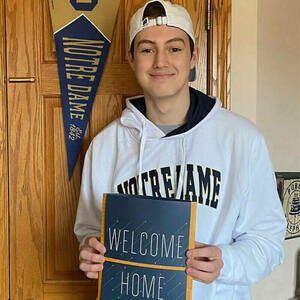
Jake Weber '24
Majors: Neuroscience and behavior
What I do:
I am a research assistant for the Sleep, Stress, and Memory (SAM) Lab under the direction of Dr. Payne. The SAM lab is a large lab, with many different studies being conducted at the same time. Currently, I am a project team lead for a study being conducted with a $900,000 grant from the National Science Foundation.
This four-year study aims to understand the effect of sleep on the consolidation of emotional memory. We use electroencephalography (EEG), eye tracking, actigraphy, and behavioral data to help us better understand how sleep strengthens and changes memory.
Other studies in the lab focus on how sleep and stress affect problem solving, memory, and college student success.
How I got started:
After my junior year in high school, I knew I wanted to research sleep. As a neuroscience major, I have always found it fascinating how little is known about sleep, despite it accounting for a third of our lives! I wanted to explore the implications of sleep on our daily lives, as well as the actual processes of sleep itself.
At the end of my freshman year, I began searching for the best way to do this. I was able to locate the SAM lab via the Department of Psychology Research Lab directory. After a meeting, application, and interview process, I was granted a position in the lab.
What I've learned:
My experience in the lab has been an extremely impactful and informative experience. I have learned how to sleep score (that is, identify a particular stage of sleep based on brain activity), how to collect and process eye-tracking data, how to program in R and MATLAB, how to collect and process EEG data, and much more.
On top of these skills, I have also learned so much about the intricacies of conducting research, especially with human participants. I have been able to practice working with (and leading) groups in professional settings and report to some amazing post-docs (Kristin Sanders and Dan Denis) and graduate students (Carissa DiPietro). Working as an undergraduate researcher has been an amazing way to develop both my soft and hard skills, as well as explore something I am passionate about.
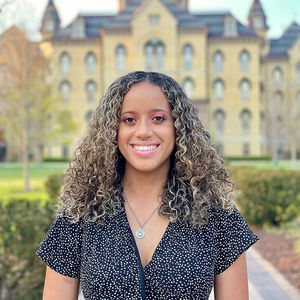
Eliza Smith '23
Majors: Psychology, peace studies
Minors: Cyber safety and security, Italian
What I do:
I am an undergraduate research assistant of the Center for Advanced Measurement of Personality and Psychopathology. I work in the Forensic and Law Psychology department of our lab under Claire Scott-Bacon, a graduate researcher in our lab. In our section of the lab, we focus on criminality, dark traits, intelligence, aggression, psychopathology, autism, and juror decision-making.
I am currently on a project with another Undergraduate RA and Claire in which we are looking at intelligence, autism, dark traits, and aggression. My independent research project focuses on specific psychopathological disorders like Schizo-affective disorder, Anti-Social disorder, Perfectionism, Depression, and Anxiety and how they correlate with aggression.
I hope to be able to craft this research into a legal discussion about claiming mental illness as the reason for a perpetrator’s actions and how we need to provide better mental care to criminals even if after committing a crime. A subset of this study is to look at how different demographics like gender, sexual orientation, political affiliation, and race play into a person having psychopathologic disorders, aggressive tendencies, and how to better cater towards their mental health needs.
How I got started:
I was inspired to study psychology after one of my good friends was diagnosed with severe depression and suicidal ideation. After I spent time trying to find ways to help her and understand what was happening to her mind, I started thinking about other things that I had trouble understanding.
One of the most impactful memories I reflected on was the murder of my uncle and cousin. I had so much trouble trying to grasp what would lead a person to do such a horrible thing, but then I thought of other criminal activity that is difficult to understand how a person could do this. I thought psychology was a sufficient avenue to explore these reasons. With that being said, when I came to Notre Dame I explored ways to study psychology, law, and different cultures in order to understand people’s minds to a greater extent and understand differences between minds.
In my second semester here at Notre Dame, I took Psychology of Personality with Dr. Watson where he discussed his lab and research at length. I knew I had to join. I applied and within ten minutes of my interview, I met Claire who instantly wanted to help me and work together. I joined the lab in the following weeks, and I threw myself headfirst into all of my intellectual aspirations in order to help the mentally vulnerable and improve our criminal justice system.
What I've learned:
Throughout my time in the lab, I have been able to grow as a researcher. The hard and soft skills I have been able to cultivate like presenting, data analyses, and scale creations have put me in a position to produce proper research that has the potential to improve livelihoods and the legal frontier. It has also put me in a great position to continue my research in graduate school, and then take this research to law school and practice.
The most critical thing I have learned through my research is the complexity of these issues. Stigmas regarding mental illness both in and out of the courtroom are stagnant and need a large group of dedicated individuals who will research these topics to show why it is necessary to talk about mental well-being. Being able to see that there are confounding variables that go beyond just biology that can affect a person’s mind and decision-making, has made me more aware of the importance of a person’s background when considering their psyche.
Lastly, I have learned how necessary it is to have these conversations for the benefit of society as a whole, but especially to help those vulnerable and at-risk to both crime and psychopathology.

Matt Kianpour '24
Major: Science-Computing
Minors: Compassionate Care in Medicine, Poverty Studies, European Studies
What I do:
I am an undergraduate research assistant for Professor Vania Smith-Oka. She is a cultural and medical anthropologist who specializes in the effect of institutions (medical, economic, development) on the behavior and choices of marginalized populations, especially women.
The Culture of Medicine Lab meets each week with Professor Smith-Oka, receiving guidance from her as we work on the lab’s projects. Currently, I am working on the The Latinx Obstetric Violence Project. The project explores obstetric violence as women share their birthing experiences through poems, short essays, drawings, paintings, embroidery, and more, calling attention to the impact obstetric violence has on mothers.
How I got started:
Before matriculating to Notre Dame, I felt that I was at a crossroads, torn between my professional interests in the sciences, but also, justice-based work.
However, through Notre Dame’s flexibility of its curriculum, I became interested in pursuing the intersection of my interests: medicine and society. I got involved in the Health, Humanities, and Society department as a first-year, where I met Professor Vania Smith-Oka. The program approaches medicine and healthcare through its institutional structures, economic and political spheres, and systems of cultural practices, which fascinates me.
As I learned more about Professor Vania Smith-Oka’s work, and how it aligns with my interests in becoming a physician, she agreed to take me on in the lab.
What I've learned:
As a student of the College of Science, my initial impressions of research were limited to laboratories, lab coats, and science. However, after working under Professor Vania Smith-Oka, my perspective on research has expanded, learning more about social science research and ethnography.
After working on the The Latinx Obstetric Violence Project, I now understand that research can directly affect others, and it is not just for the exclusive spheres of academia.
My work as a research assistant has confirmed to me my interests in becoming a physician that is aware of how patients can be deleteriously affected by the institution of healthcare.
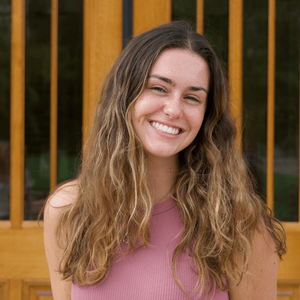
Nicole Campbell '23
Major: Neuroscience and behavior
Minor: Education, schooling, and society
What I do:
I work in the Cognition, Learning, and Development Lab (CLAD) on campus with Professor Nicole McNeil. In our lab we conduct research regarding mathematical cognition in children, working with students to build our understanding of the way students learn and understand math.
My first project in the lab was helping code data for a senior’s thesis project, and since being in the lab I have had the opportunity to work directly with student participants, conduct literature reviews, and present our findings at a conference in Antwerp, Belgium.
This year, I am working on an independent research project for my senior thesis in the lab, investigating the relationship between analytical thinking and conceptual math understanding in middle school students.
How I got started:
My sophomore year, I reached out to a few various professors via email that were conducting psychology research, and Professor McNeil’s lab stood out as a blend between my interests in neuroscience and education.
Once we met on Zoom for the first time, I loved Professor McNeil’s excitement for the work that the lab was doing, and I quickly joined the winter of my sophomore year.
What I've learned:
Through my time in the CLAD lab, I have learned a great deal about what math cognition is, and why it is important. I have gained a deeper understanding of the many facets of learning math, and how this impacts all students.
In terms of research skills, I have become proficient in data analysis through lots of practice, have developed a more critical lens in conducting literature reviews and understanding research, have refined my presentation skills, and have become much more confident in my skills working directly with students.
I want to go into a career of psychological research, and my time in the CLAD lab has given me the skills to feel confident in doing so!
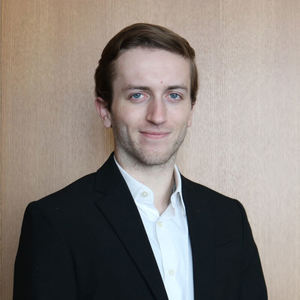
Robert Crawford '23
Major: Architecture
What I do:
The primary goal of my project was to determine the energy savings that could be produced by retrofitting solar panels on the roofs of a group of HUD-owned [Department of Housing and Urban Development] apartment buildings in South Bend.
Roof dimensions and angles were taken from Google Maps and other GIS maps, and particular attention was paid to roof features that would prevent solar panel installation, including chimneys and vents. The position of nearby trees was also marked in order to know which solar panels would be partially in shade.
Annual average energy production was calculated after determining the proper angles, dimensions, solar irradiance, and panel efficiency. The final results of this research showed that the proposed installation would provide more than 85 percent of the energy normally used in the apartments.
How I got started:
My sophomore year of college, I became very interested in sustainability. It is both a personal mindset and a professional practice that is an imperative for creating a habitable world for the future. Within the field of architecture, green building must become the standard of design, as soon as possible.
I joined the sustainability minor during my sophomore year and have since been taking a variety of classes on the topic. A number of papers for these classes were research-based, and I was excited by the prospect of learning more about some of the most important facets of sustainability. During the fall semester of my junior year, I approached Professor John Onyango of the School of Architecture and he helped me devise a research plan focused on solar energy.
What I've learned:
My research introduced me to the basics of solar panel construction and installation, which has been helpful in filling in some of the gaps in my knowledge of green design. It also revealed the difficulty of acquiring relevant data and information on the topic—at many points, finding the proper equation or the correct numbers was nearly impossible. It is going to be incredibly difficult to introduce the technology of solar panels and other renewable energy products into the public realm without better, clearer sources of information.
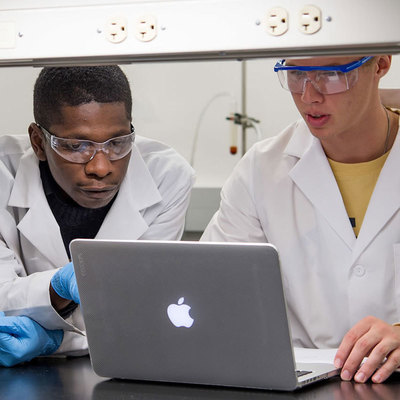
Ready to dig into research opportunities at Notre Dame?
- Check out the Flatley Center for Undergraduate Scholarly Engagement (CUSE) to get started. CUSE also advises students through the application process for prestigious programs, such as Rhodes and Fulbright so they may pursue research and scholarship after graduation.
- Learn about our approach to undergraduate research.
- Each college and school at Notre Dame is home to centers and institutes that facilitate student research. Visit individual college websites to learn more: